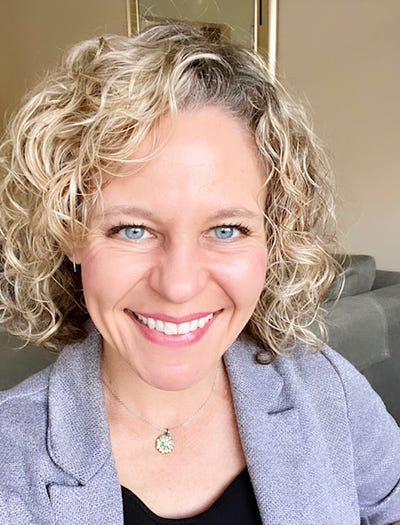Q&A: Whole Foods Global EVP Christina Minardi on Building a Local Love Story
'How do we have that romance online for our customers—the romance of food?'. With no food sampling in-stores and many consumers doing at least some of their grocery shopping online, how can a brand support new-product discovery—and the basket sales boost that comes from it?

Christina Minardi is EVP of operations for Austin, Texas-based Whole Foods Market. In that wide-ranging role, she leads real-estate strategy, e-commerce integration and growth, and culinary innovation, with a focus on tailoring product mix and store designs themselves to local communities.
A New Jersey native who grew up in a family-owned bakery, Minardi has more than 25 years of experience with Whole Foods, joining the leadership team at Fresh Fields in Millburn, N.J., in 1995 before that store's acquisition by Whole Foods. In 2016, Minardi was named one of Food & Wine and Fortune magazines' Most Innovative Women in Food & Drink. She was promoted to her current role at Whole Foods in 2018.
Before the COVID-19 pandemic took hold, Minardi typically spent three weeks of every month on the road visiting new and existing stores. It's something she's eager to get back to. "I’m looking forward to hopefully being able to open stores in a little less stressful situation than we had this past year," Minardi said in a recent interview with WGB. "And being able to just break bread—we break bread at our openings ... I’m looking forward to when we can actually break bread and eat bread together again."
Minardi spoke with WGB about how culinary discovery has changed amid the pandemic and areas of opportunity she sees for Whole Foods in 2021.
Christine LaFave Grace: In terms of customers’ journey of culinary discovery, what shifts have you seen in the past year?
Christina Minardi: COVID has been a terrible thing, but one good thing that I’ve seen come out of it is how much more people are cooking and going back to their roots of baking bread. And not just that, but sharing recipes and having gardens—I don’t see that going away. I think that’s a discovery for people. It’s almost like a reset for some folks, and I think that’s really going to continue: being closer to the food, closer to where it comes from, and just more cooking in general. That’s been one positive thing that’s come out of this.
As you look forward from a product standpoint, what kinds of things do you see people continuing to gravitate to?
Throughout the year what we’re focusing on is, you know, we’ve always done local. It’s really what Whole Foods has been built on. What we haven’t done always a great job on is getting the word out there about how much we really do support local or showing up local really well in our stores. So we have invested in making sure that this year we’re building up that well for our customers.
We just hired Will Betts, he was from our Pacific northwest region, and he’s our new VP of local. He’s assembling a team that’s really going to ensure that we have a robust local program that’s microlocal in the communities that we’re in that continues to help our local vendors grow with us.
I look at so many brands that I know that started with us that are big gigantic brands now, and I don’t think people ever realize that. We want to continue to really do that for our small vendors.
For consumers now and post-pandemic who will choose to do at least some of their shopping online, how do you bring some of that local vibe, the local flavor, into the online shopping experience? Is that something that’s important?
Yeah, it definitely is important, and we’ve talked a lot about it. COVID propelled us [and made] home shopping a lot busier than we thought we were going to be at this point, so we had to move quickly. Now we need to really ensure that we are doing the most that we can to have the experience online be reflective of the experience in store. We’re working on that.
I always tell the story—it’s like during the holidays when you go into specialty and you’ve got that great brie, and we’re also selling you the dried cranberries that go with it, and the big round bread that you hollow out and put [the brie] inside of it, and then the nuts, and the jam—we need to show that up online as well during the holidays for customers that may not want to come in, but they want that special holiday item, and they want to be able to easily build it online.
Those are some of the things that we’re talking about and we’re going to implement. How do we have that romance online for our customers—that’s what I call it—the romance of food?
What has culinary innovation and discovery looked like for Whole Foods in the past year?
In June, I put together a new food innovation group, a working group, that tried to pick people from all different parts of the business to really do just that: to continue to find really unique products and trends. We have great category managers; we do a lot of research; and they’re doing that job every day, but this group was really kind of another level of [getting] different people at all levels to come together and just keep pushing food innovation and keep the passion in food in everything that we do.
I do these coffee chats with store team leaders, and they’re always asking me different questions, a lot of technical questions, and then I often find myself saying, “But don’t forget, we’re in the great-food business, and that’s what’s most important.”
In this world that we’re in right now in our stores, we really encourage our team members to share that passion for food, share with customers recipes from your childhood. If you’re selling a roast, talk about the roast that your grandmother made and the recipe that goes with it. That’s really what we have been encouraging more and more in our stores to keep that connection going, especially when sampling’s been a little bit harder. We really want to share that passion for food. Even when I go to stores, at the holidays when I was helping at stores, I was constantly giving recipes out to customers; it’s one of the things I love to do.
As consumer shopping patterns and expectations continue to shift, what’s most important for maintaining and cultivating brand loyalty?
I think that this past year, we did a really good job quickly in taking care of our customers and our team members when COVID really started to take hold. We were one of the first retailers with the masks, temperature checks for our team members, wiping down all the carts; we got rated as one of the safest supermarkets to shop, and I think that has given us great brand loyalty with our customers. Even just to hear family and friends say how comfortable they feel shopping with us—I think that will continue to stay with us. I hope it does. We’ve worked really hard; it’s really important for us to take care of our team members and our customers, and we’re going to continue to do whatever we have to to keep them all safe.
And then also ensuring that we’re delighting the customers that come into our stores, that they have a great experience, that they’re excited by what they see and smell in the stores, and hopefully tasting when they can get back to tasting in our stores. That’s what Whole Foods is built on.
We don’t have cookie-cutter stores; they’re all different, and they’re designed in the communities that they’re in. We spend a lot of time designing our stores and building them so they fit that way, and that’s something that we pride ourselves on.
We’ve always been a second home for a lot of our customers, a gathering place, and when COVID’s over, we want to be that place again for people. So many people would say to me, "I come to Whole Foods and I feel like I’m home." We want to be all of that again.
Where do you want to continue to grow in the year ahead? What opportunities do you want to seize; what do you want to be talking about at the end of 2021?
I think this year is about recovering from the year that we had and [looking at] customers’ patterns of shopping and being sure that we are supporting the ways that our customers shop, and really focusing on prepared foods. When COVID happened, we shut down our salad bars and our food bars; we have a focus on, when they can come back, we will work on getting them back. We have them now in some municipalities where they are allowed. They obviously are up and running in a full-service way, where we have team members that are serving them, and it’s working well. But our focus is really, how do we continue to grow prepared foods?
We’ve got a great culinary team in Austin that’s run by Jeff Turnas, and he’s creating some great new venues. We just launched Market Burger, that’s a burger venue in multiple regions now, and it’s an organic, grass-fed burger program. There’s a lot of places you can get burgers, but there’s not too many places that you can get a really good grass-fed organic burger. When we do these menus, they’re going to be really reflective of Whole Foods Market. If we do a taco, it’s going to tell the story of Whole Foods Market and our standards in that taco. We are just launching a new Spanish street-food [venue] as well, and again, all of our high standards will be behind each of these venues to tell a great story. So that’s definitely going to be a big focus in this coming year.
Is there anything you’re taking away from the past year that has changed you, that imbues your view of how you work or how you will approach a problem?
I think the quickness of our decision-making. I think what we have done shows that you don’t need to have an eight-hour meeting—thank God, because I’m not a big fan of those. You can get a lot done with quick, one-hour meetings. Have an agenda, have a document, and move forward. That’s worked really well for us, and that’s not something that’s going to go away. And I can’t stress enough—I’ve worked with a lot of our team for many, many years, but we really came together as a family, and with a lot of love. We’ve had some stressful times, but we really pulled through together, and you really need that when things get tough. Being able to make decisions quickly and make the right decisions, for any company that’s going to make them stronger.
Read more about:
Whole Foods MarketAbout the Author
You May Also Like






